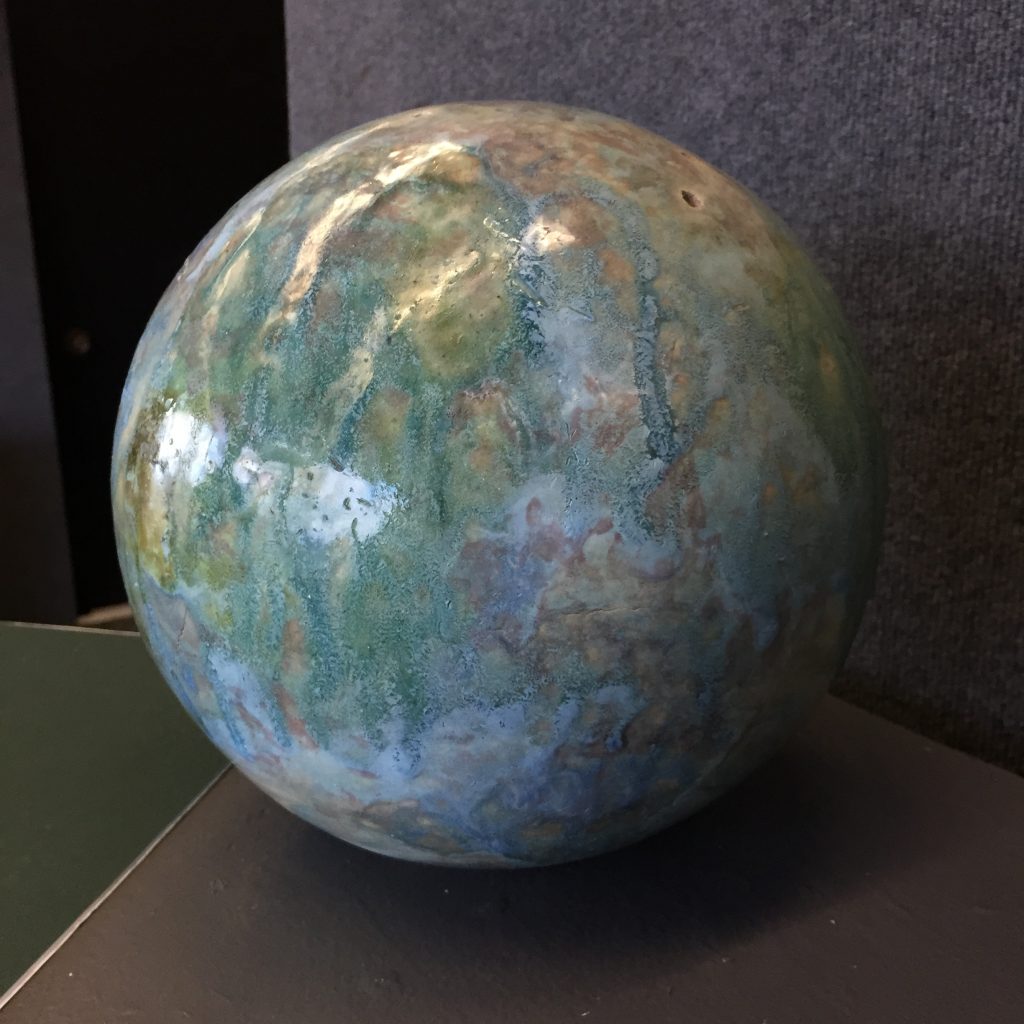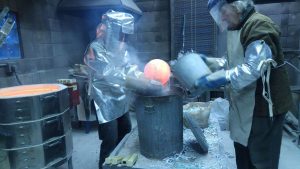Raku creation
 This is a ceramic representation of the earth as originally imagined in an Iroquois creation myth of the “world on a turtle’s back.” In the original myth the world rests on the back of a giant turtle, the American Indian equivalent of the Medieval notion of a firmament. In Barron Naegel’s reworking of the myth, the turtle and the planet are fused into one orb, the shell forming the bedrock below the life on the surface. Which happens to be, more or less, close to the way we view the planet ourselves. In Naegel’s small solo show at Keuka College you can see his latest figure drawings and his reinterpretation of the Iroquois myth in raku pottery. The drawings are masterful and traditional, studies from models at Steve Carpenter’s studio, and bring to mind the Renaissance and the Grand Central Atelier, though in them he’s trying to find a middle ground between representation and abstraction. One in particular, a cluster of figures woven together into a braid of limbs, brought to mind Nude Descending a Staircase. His raku planet is the show’s stand-out, and it was literally a trial by fire, a spontaneous process of discovering color experimentally through chemistry and heat–turning him into a bit of an alchemist. Here is how Barron described the process of getting the orb to its finished state through “re-oxidation”:
This is a ceramic representation of the earth as originally imagined in an Iroquois creation myth of the “world on a turtle’s back.” In the original myth the world rests on the back of a giant turtle, the American Indian equivalent of the Medieval notion of a firmament. In Barron Naegel’s reworking of the myth, the turtle and the planet are fused into one orb, the shell forming the bedrock below the life on the surface. Which happens to be, more or less, close to the way we view the planet ourselves. In Naegel’s small solo show at Keuka College you can see his latest figure drawings and his reinterpretation of the Iroquois myth in raku pottery. The drawings are masterful and traditional, studies from models at Steve Carpenter’s studio, and bring to mind the Renaissance and the Grand Central Atelier, though in them he’s trying to find a middle ground between representation and abstraction. One in particular, a cluster of figures woven together into a braid of limbs, brought to mind Nude Descending a Staircase. His raku planet is the show’s stand-out, and it was literally a trial by fire, a spontaneous process of discovering color experimentally through chemistry and heat–turning him into a bit of an alchemist. Here is how Barron described the process of getting the orb to its finished state through “re-oxidation”:
Raku can be a scary process, to say the least. I usually use tongs to remove the work. However I had to use an alternative approach, which in this case was to just grab it. I had all this  apprehension about heat, so I used firemen gloves blanketed with phone books completely saturated in water. First of all, I don’t have a Raku kiln which makes this process a lot, lot easier. So I basically have to lean over into the heat. The object itself is molten and it’s about as heavy as a bowling ball, but one with oil all over it, because of the molten glass. A slippery bowling ball at 1900 degrees! The process of Raku is based on reduction: it’s all chemistry. I’m stripping away the oxygen from the
apprehension about heat, so I used firemen gloves blanketed with phone books completely saturated in water. First of all, I don’t have a Raku kiln which makes this process a lot, lot easier. So I basically have to lean over into the heat. The object itself is molten and it’s about as heavy as a bowling ball, but one with oil all over it, because of the molten glass. A slippery bowling ball at 1900 degrees! The process of Raku is based on reduction: it’s all chemistry. I’m stripping away the oxygen from the glaze and introducing more carbon, which changes the metal colorants. How did I get it to where I wanted it? The blue and green you see on the surface are the result of re-oxidation. The first time I fired it, it came out red, looking more like Mars! I reheated it to about 800 degrees a baseline temperature, and then with a welding torch reworked areas to get certain colors. I had to try three times to get it to work out.
glaze and introducing more carbon, which changes the metal colorants. How did I get it to where I wanted it? The blue and green you see on the surface are the result of re-oxidation. The first time I fired it, it came out red, looking more like Mars! I reheated it to about 800 degrees a baseline temperature, and then with a welding torch reworked areas to get certain colors. I had to try three times to get it to work out.
Using firemen’s gloves and wet phone books as a buffer between the gloves and the pottery, which would have stuck to the molten glass, he was able to retrieve his globe from the fire. It’s an unpretentious technique also used at the Corning Glass Works for handling molten forms only an hour’s drive away. It struck me that with his ceramic planet, Naegel was replacing oxygen with carbon in the surface to get the color he wanted, much as we’re doing (sort of) to the actual planet, but in his case, it had exactly the desired effect: turning a dull red sphere into this emerald world.
Comments are currently closed.